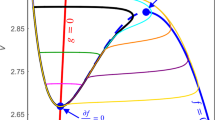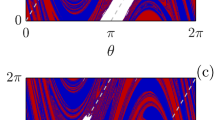Abstract
Presentation functions provide the time-ordered points of the forward dynamics of a system as successive inverse images. They generally determine objects constructed on trees, regular or otherwise, and immediately determine a functional form of the transfer matrix of these systems. Presentation functions for regular binary trees determine the associated forward dynamics to be that of a period doubling fixed point. They are generally parametrized by the trajectory scaling function of the dynamics in a natural way. The requirement that the forward dynamics be smooth with a critical point determines a complete set of equations whose solution is the scaling function. These equations are compatible with a dynamics in the space of scalings which is conjectured, with numerical and intuitive support, to possess its solution as a unique, globally attracting fixed point. It is argued that such dynamics is to be sought as a program for the solution of chaotic dynamics. In the course of the exposition new information pertaining to universal mode locking is presented.
Similar content being viewed by others
References
M. J. Feigenbaum, Universality in Complex Discrete Dynamics, LA-6816-PR: Theoretical Division Annual Report, July 1975–September 1976, Los Alamos;J. Stat. Phys. 19:25 (1978);21:669 (1979).
D. Ruelle,Statistical Mechanics, Thermodynamic Formalism (Addison-Wesley, 1978).
E. B. Vul, Ya. G. Sinai, and K. M. Khanin,Uspekhi Mat. Nauk 39:3 (1984) [Russ. Math. Surv. 39:1 (1984)].
M. J. Feigenbaum,J. Stat. Phys. 46:919, 925 (1987).
T. C. Halsey, M. H. Jensen, L. P. Kadanoff, I. Procaccia, and P. I. Schraiman,Phys. Rev. A 33:1141 (1986).
M. J. Feigenbaum, inProceedings of the 1987 Noto Summer School.
M. J. Feigenbaum, I. Procaccia, and T. Tel, The scaling properties of multifractals as an eigenvalue problem,Nonlinearity, submitted.
M. J. Feigenbaum,Phys. Lett. 74A:375 (1979).
M. J. Feigenbaum,Commun. Math. Phys. 77:65 (1980).
M. J. Feigenbaum, inNonlinear Phenomena in Chemical Dynamics, C. Vidal and A. Pecault, eds. (Springer-Verlag, 1981).
M. J. Feigenbaum, L. P. Kadanoff, and S. F. Shenker,Physica D 5:370 (1982).
D. Rand, S. Ostlund, J. Sethna, and E. Siggia,Physica D 5 (1982).
M. J. Feigenbaum, inNonlinear Phenomena in Physics, E. Claro, ed. (Springer-Verlag, 1984).
H. A. Gutowitz, J. D. Victor, and B. W. Knight,Physica 28D (1987).
Author information
Authors and Affiliations
Rights and permissions
About this article
Cite this article
Feigenbaum, M.J. Presentation functions, fixed points, and a theory of scaling function dynamics. J Stat Phys 52, 527–569 (1988). https://doi.org/10.1007/BF01019716
Issue Date:
DOI: https://doi.org/10.1007/BF01019716




